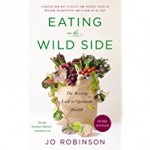 When faced with an ever increasing array of fruits and vegetable in grocery stores, specialty stores, and Farmers’ Markets, it is difficult to decide what foods to choose for the healthiest diet. Jo Robinson’s book, Eating on the Wild Side, offers advice to make these choices easier. Believing that agricultural practices have resulted in fruits and vegetables that are high in starch and sugar and low in vitamins, minerals, fibers, and antioxidants, she shows that we can choose select varieties that can reclaim the nutrients that have been lost because of poor choices made in the past.
When faced with an ever increasing array of fruits and vegetable in grocery stores, specialty stores, and Farmers’ Markets, it is difficult to decide what foods to choose for the healthiest diet. Jo Robinson’s book, Eating on the Wild Side, offers advice to make these choices easier. Believing that agricultural practices have resulted in fruits and vegetables that are high in starch and sugar and low in vitamins, minerals, fibers, and antioxidants, she shows that we can choose select varieties that can reclaim the nutrients that have been lost because of poor choices made in the past.
The book is divided into two parts, the first dealing with common vegetables from greens to artichokes, and the second dealing with fruits from apples to mangoes. Each chapter is devoted to a specific fruit or vegetable group and includes a history of its wild origins, earliest cultivation, healthful properties of wild varieties and the changes that have taken place as a result of cultivation. Robinson details the most healthful varieties available today and makes suggestions for selecting, storing and cooking them. We learn, for example, that Golden Delicious apples are far less nutritious than the other popular available ones, golden raisings have more phytotoxins than black raisins, and that orange juice made from concentrate has 45% more flavonoids than juice that has never been concentrated. To get full health benefits garlic should be allowed to rest ten minutes after cutting before being cooked, carrots should be steamed or sautéed whole and then cut up, and that that boiling artichokes increases their antioxidant levels but steaming increases them even more. Each chapter ends with a list of key points.
Eating on the Wild Side is packed with informative and mind titillating information and contains many suggestions that can easily be incorporated into everyday life with positive health benefits. The text is written in simple language even when discussing some complex issues. Robinson is a health writer and food activist who has also written about the benefits of raising of livestock on pasture rather than in feedlots. Her book, Eating on the Wild Side, concludes with an extensive section entitled “ Scientific References” which lists the research citations by chapter in order of their relevance within the chapter, but there are no footnotes in the text.
To buy Eating on the Wild Side from Amazon.com Click Here.